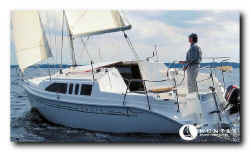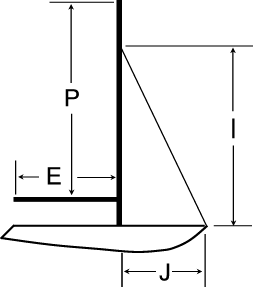|
H26
vs. H260
|

|
|

|
|
Hunter 26 |
|
Hunter 260 |
|
Click to Expand any Picture |
The following information was collected from a number of
unofficial sources. If you have corrections or changes please let us know.
The H26/H260 series evolved over time based on users desires and
complaints and is looks very similar to the H23.5, also water ballast.
The H26 was
built from 1994 to 1998. The H260 was manufactured from 1998-2005. It is
believed there was some overlap between the production of the two models. Some
changes were stylistic, others like the rudder were functional. Apparently the
hull numbers for the 26 start at FOOO1 and run to somewhere near F0729 around
1997-98 then the 260 is introduced and the hull numbers continue until 2002 were
they start new (maybe Hunter started a whole new mold instead of using the one
that was modified from the 26 and run to somewhere near F0189 in 2005). My boat
is hull number 089. Neither boat is in production but there are many good used
boats available on the resale market.
- Both boats look and sail about the same and have
similar displacement.
- The hull and deck are the same except for the cockpit and windows and
stern.
- If exiting the transom, the 260 will have a step off and "sugar
transom, the 26 did not.
- The 260 has a place for a helmsman seat which is the lid for the gas locker.
- Very early H26 models were mostly tiller, the
wheel option is more common in the H260. Although a few of the H26 had
wheel steering, The 260 was designed to accommodate this popular option. The
260 had interchangeable floors to accommodate the wheel steering that is
reinforced underneath.
- The dry weight of the H260 is actually greater than that
advertised by Hunter. For example, my H260 is essentially stock but weighs
4400 lbs with water and outboard.
- H26 had removable mini-shrouds to keep the mast in-line
during raising. The H260 uses solid mast
supports.
- The H26 has a plexiglass forward vent window instead of a
hatch. This was eliminated in the H260 and replaced with a hatch on the foredeck.
- H26 owners report the sliding hatch in H26
leaks - H260 is fairly dry - a companionway cover is a popular solution.
- Stern seats option are very common in the H260; earliest
model H26s did not have stern rail seats as option. It is possible to back fit
these but it's not cheap.
- Cockpit table, standard in H26 was eliminated in
H260 (There is still a place in the v-birth for storing this table in the H260)
- Jib sheet/winch layout are slightly different.
- H260 has a different non-slip pattern in cabin
and cockpit.
- H26 has a small port in aft bunk; the H260 aft bunk has a
large window that allows air circulation and is an escape hatch when you are using the transom
bunk.
- The anchor locker and bow cleat configuration
is much improved on the 260 and allows for the installation of an optional
anchor roller.
- Some very early model year 26's had 7/8" rail
and some had 1" rail.
- The stanchions in the later H260's were beefed up.
- The companionway opening is narrower on the
260 (the sliding cover is the same width on both.)
- H26 has porta-pottie, the 260 cabin sole in
the head is raised to allow for a marine head option.
- The H26 uses 5 gal. collapsible tank for
water, the H260 has a 20 gal. water tank under the v-berth.
- The H26 has thru-hulls with no valves that
exit above the waterline, the H260's thru-hulls have valves and are below the
waterline.
- The rudder assembly and transom is completely
different between the two boats. The H260 rudder
is fragile and prone to cracks.
Other comments:
In appearance, the stern is the most noticeable difference. The 260 has a fold
away swim latter and sugar scoop stern and the rub rail sweeps continuously from
the side around the back. On the 26's the stern is squared off and the ladder
folds up to fill in the stern railing. 1998 was the first model year with the
new transom and rudder design.
Another significant difference between a 26 and 260 is the rig. The 26 uses a
full batten main, and the mast does not have fixed support struts like the 260
does. The H260 has a extra diagonal shroud that makes it a true B and R rig. The
H260 main has a full roach with two full and two partial battens.
The major difference in the interior is that the galley fiddles and trim on a
H26 is smoked Plexiglas, in the 260 it is teak. There is a cabinet in the galley
and a single burner butane stove in the 260, the 26 uses a drop in two burner
Origo 4000 alcohol stove. The head door is teak on the 260, white fiberglass on
the 26.
The centerboard in both boats weighs
less than 100 pounds. It was made in two halves and around
60 lbs of lead added before bonding the halves. It is built with a sleeve for
1/2" pivot bolt.
That said, the boats should sail the same and
are of excellent construction. The differences are a matter of preference. The
biggest impact will be cost. A 2002 H260 will cost about $10K more than a 5 year
old H26. The older boat may have some wear and tear, but is likely to have more
owner installed gear like a compass, GPS, Autopilot, etc.
|
Specifications |

|
|
H26 |
H260 |
| Years Built |
1994-1998 |
1998-2005 |
| LOA |
25' - 9 in |
26' - 3 in |
| LWL |
23' - 1 in |
23' - 3 in |
| I |
28' - 4 in |
29' - 2.5in |
| J |
09' - 5 in |
09' - 5.5in |
| P |
30' - 1 in |
30' - 6.5in |
| E |
10' - 6 in |
10' - 6 in |
| Sail Area |
290 sf. |
320 sf. |
| Mast Height |
40' - 4 in |
40' - 0 in |
| Water |
05 gal |
20 gal |
I = distance between top of forestay to the foredeck
J =distance from forestay chainplate to mast
P =distance from boom to top of mast
E =length of boom
Mast height = Height of mast from waterline
|